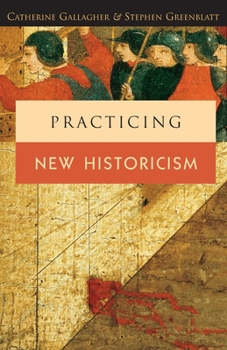Practicing New Historicism
Select Format
Select Condition 
Book Overview
For almost twenty years, new historicism has been a highly controversial and influential force in literary and cultural studies. In Practicing the New Historicism, two of its most distinguished practitioners reflect on its surprisingly disparate sources and far-reaching effects. In lucid and jargon-free prose, Catherine Gallagher and Stephen Greenblatt focus on five central aspects of new historicism: recurrent use of anecdotes, preoccupation...
Format:Paperback
Language:English
ISBN:0226279359
ISBN13:9780226279350
Release Date:September 2001
Publisher:University of Chicago Press
Length:260 Pages
Weight:0.70 lbs.
Dimensions:0.6" x 5.5" x 8.7"
Customer Reviews
2 ratings
"Scrupulous But Unprincipled Orgasmic Essays With Emissions"
Published by Thriftbooks.com User , 17 years ago
"Practicing New Historicism", Catherine Gallagher and Stephen Greenblatt - Univ. Chicago Press, ISBN: 0-226-27935-9 (PB) - 234 pages plus Index (15 pags), 8 1/2" x 5 3/8" A prime exemplar expounding construct of "Representations" (plural) to articulate equitable confines to encapsulate, embody and validate archetypal literary receptacles for a presumptiously new discipline, a "field" of rumination, coerced by heralding exigency of a job register (yes!) for the MLA (see book explanation of abbreviation). B.E. Seedy in 1883 had already warned us of this coming calamity. Vigilantly, the authors dissected their MS into six organic parts or entrails, two "about", and four "of" new historicism, allowing spurious ectasy, relish and anabolism of punctilious emissions, some of who/which conjure blemishes of/with disbelief, biliousness, and even "high-brow" prefunctories, albeit allowing binary synapses to "fine tune", in ephemeral sequentiality, liberating unspecified primeval "bit of fire" and fracture of DNA that possibly (but exclusively admitting a 'peewee' likelihood), of its repression (17.3 n)to aggrandized antidiluviuan RNA, primeval matter most (almost?) disgusting to the disingenuous, partly due to lack of learning, laziness and autisms. 'Litterateurs' faithful but protracted disquisitions with reference to theology (...Religioso...), agreeably wrangled with Corpus Christi, dead bodies, undead bodies, Resurrection, resucitation, "almost-dead", the Host or "altar bread", "money changers" (Jews), and also relatively antiquated pious paintings, caves with missing walls (for illuminatio...)askew 'parterre', tiles and varmint breaches to exude bodily fluids including 'reyd' blood. Undoubtedly, authors sanctioned or "put in tune" their sage moils, fluidly, but not invariably sensitively enough(?) though, to evoke deep-seated Freudian repulsions of earthy matters or "materiel", as the boorish potato(oes) question, Irish (as people of Earth or muck), pigs, but coupled with embodiments of cherished participants in immigrant 'novellae' as Hamlet, Great Expectations, and even the Holy writ. The Holy writ being published under many names and divers language. All in all, those particular disciples with penchants to harvest prodigal sagacious perspicacity fancy spoils from abstruse contemplation of this adamantine (sic) proportion of line and mass, a "near" depraved profliagacy but also a cunning artform best shielded from juveniles who lack understanding of perverse perspectives of historicists, both old and new! Guard these with your life! J.B. Wharton in 1932 had cautioned: "Be chary in these trouble times where worldwide more than one language is "lost" weekly, the 'hot' area being Australia what with its Aborigine(s)". Yes, (T)roubled times as who now still reminisces his Morse code and pidgin? Amelia Earhart having untutored in the former and unskilled in the latter. Even the idiot savant must ponder these grave issues. The authors are to be
Waiting for a Theory of Practice
Published by Thriftbooks.com User , 24 years ago
Written by the two leading practitioners of New Historicism, this book is the most valuable reference up to date demonstrating the power, as well as the weaknesses, of this peculiar "method" of reading. The first three chapters on methodology advocate the immanence of (counter)historical particulars and anecdotes, which explains the authors' reluctance to endorse any transcendental abstraction of theory. Paradoxically, the historical sense as well as literary "taste" (the valuation of difference, details, ruptures) that Greenblatt and Gallagher embrace is recognisably shaped by contemporary theoretical interventions, but this debt to theory is obscured as a result of their disavowal of any "methodological directives." This obstinate disavowal, worse still, seems to join force with the conservative current of "Against Theory" in the name of history (the very motto put forward by some critics who are also related to New Historicism). The next four chapters are the "practice" part, where the authors obviously feel more at home. Their close reading and deft montage of a wide variety of discourses or artifices (drama, fiction, paintings, theological and economic debates, medical treatises...) is marvelous and dazzling, testifying how much New Historicism has widened the horizon of literary criticism. The juxtaposition of topics (the Host and the potato, the wicked sons in Hamlet and Great Expectations) also throws unexpected light on the materials. Yet the question remains: how to theorise further such montage or juxtaposition, if it is not entirely governed by whim?





